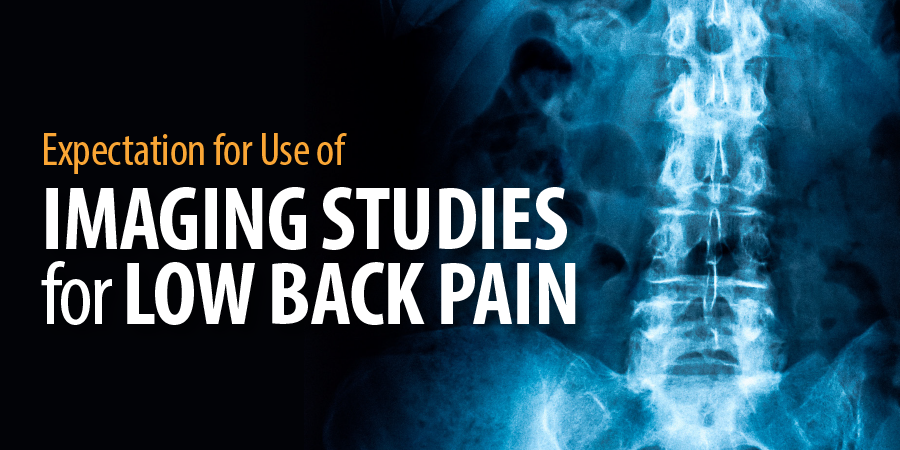

According to the American Medical Association  , low back pain is one of the leading causes of primary and emergency room visits and job related disability in the United States.1 The goal in the primary treatment of low back pain is symptomatic relief and acute reduction of pain with the attention to the following:
, low back pain is one of the leading causes of primary and emergency room visits and job related disability in the United States.1 The goal in the primary treatment of low back pain is symptomatic relief and acute reduction of pain with the attention to the following:
The Journal of Family and Community Medicine  states that careful history taking and physical examination are crucial to diagnosing the etiology of back pain with attention to strength, reflexes, spine percussion, and segmental mobility, as well as assessing pain and function. Depression screening is also recommended since concurrent coincident depression worsens prognosis.2
states that careful history taking and physical examination are crucial to diagnosing the etiology of back pain with attention to strength, reflexes, spine percussion, and segmental mobility, as well as assessing pain and function. Depression screening is also recommended since concurrent coincident depression worsens prognosis.2
According to an article in American Family Physicians  , most patients do not need imaging in the initial evaluation of acute low back pain if there are no features in the history or physical examination that suggest a specific cause. Physical examination is directed toward ruling out suspected “red flags” of lower back pain:
, most patients do not need imaging in the initial evaluation of acute low back pain if there are no features in the history or physical examination that suggest a specific cause. Physical examination is directed toward ruling out suspected “red flags” of lower back pain:
Most patients with acute back pain have substantial improvements in pain and function in the first six weeks and imaging is unlikely to improve on this or effect treatment plans.3
The American Academy of Family Physicians’ “Choosing Wisely” guidelines  indicate that physicians should not “do imaging for low back pain within the first six weeks, unless red flags are present.” Imaging on initial presentation should be reserved for when there is suspicion for cauda equina syndrome, malignancy, fracture, or infection.4
indicate that physicians should not “do imaging for low back pain within the first six weeks, unless red flags are present.” Imaging on initial presentation should be reserved for when there is suspicion for cauda equina syndrome, malignancy, fracture, or infection.4
In addition, a report by the NCQA  has found evidence that routine imaging for low back pain by using radiography or advanced imaging methods is not associated with clinically meaningful effect on patient outcomes. Unnecessary imaging exposes patients to preventable harms, may lead to additional unnecessary interventions, and results in unnecessary costs.5
has found evidence that routine imaging for low back pain by using radiography or advanced imaging methods is not associated with clinically meaningful effect on patient outcomes. Unnecessary imaging exposes patients to preventable harms, may lead to additional unnecessary interventions, and results in unnecessary costs.5
According to an article in BioMed Central Family Practice  , patients’ expectations about treatment for back pain are generally as follows:
, patients’ expectations about treatment for back pain are generally as follows:
Physicians are encouraged to specifically enquire about patients’ expectations to correct common misperceptions and open patient communication on:
Based on some findings by Practical Pain Management  , physicians may not need to provide intensive patient education. More information is not necessarily more effective. Once the patients’ intense symptomatic period is over brief educational interventions limited to 5 min to 20 min. explaining the diagnosis, treatment, and expected management plan could help bring expectations more in line with the evidence. This finding will require further research.7
, physicians may not need to provide intensive patient education. More information is not necessarily more effective. Once the patients’ intense symptomatic period is over brief educational interventions limited to 5 min to 20 min. explaining the diagnosis, treatment, and expected management plan could help bring expectations more in line with the evidence. This finding will require further research.7
Supplementing face-to-face simple, clear, understandable information with patient handouts, self-care education books, online materials, mass media educational campaigns, or other methods could be an efficient strategy for reinforcing or expanding on key points.
Sources Cited:
Highmark does not recommend particular treatments or healthcare services. This informational article is not intended to be a substitute for professional medical advice, diagnosis, or treatment. The member’s provider should determine the appropriate treatment and follow-up with his or her patient. This informational article is based upon a search of literature: there may be other recommendations or suggested practices that may be suitable in the care of patients. Coverage of services is subject to the terms of each member’s benefit plan. Additionally, state laws and regulations governing health insurance, health plans and coverage may apply and will vary from state to state.